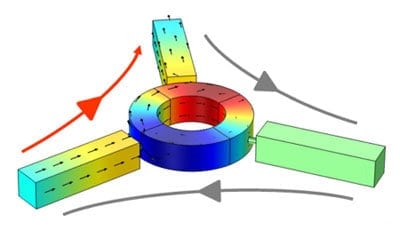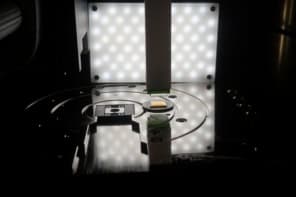
A device that allows sound waves to pass in only one direction has been created by researchers in the US. The “one-way circulator” – or isolator – for sound waves shows that the fundamental symmetry with which acoustic waves travel through air between two points in space can be broken by a compact and simple device.
While there are ways in which one can restrict or allow regular flow in a certain direction – such as traffic in a one-way street – it is much more difficult to do so with light or sound waves. This is mainly thanks to the reciprocity theorem, which refers to the symmetric transmission of waves between two points in space: regardless of the direction in which they are travelling, identical waves passing through the same medium should behave in the same way. So, it is this reciprocity that needs to be overcome to develop a truly non-reciprocal or one-way system, such as an actual one-way mirror. Currently, one-way mirrors are not in fact non-reciprocal, instead they are partially reflective and partially transparent, working by being lit unevenly.
Resonant rings
To overcome the reciprocity problem, Andrea Alù of the University of Texas and colleagues have now built a device that allows the unidirectional flow of sound. Their device is based on an electronic circulator – the kind normally used in communication devices and radars. This type of circulator is a “non-reciprocal three-port device”, in which microwaves or radio signals are transmitted from one port to the next in a sequential way. If one of the ports is not in use, the circulator begins to act as an isolator, allowing signals to flow from one port to the other but not back.
In their experiment, the researchers used three small computer fans to circulate air at a specific velocity in an acoustic resonant-ring cavity. The ring was connected to three ports of the circulator and microphones were placed at the end of each. They researchers began by transmitting sound from one port. If the fans were switched off, the sound signal from the first port split symmetrically into the two receiving ports, as expected. However, when the fans were turned on and there was a moderate air flow in the ring (with its velocity tailored to the ring design), the team found that the transmission symmetry was broken.
In this case, the acoustic signal from the first port would flow entirely into the next, leaving the third port completely isolated. Similarly, when the signal was sent from the second port, it flowed into the third, leaving the first port isolated and so on. Indeed, signals flow from the first to the second, from the second to the third and from the third to the first port – but never in the opposite directions. “We were able to create one-way communication for sound traveling through air,” says Alù. “Imagine being able to listen without having to worry about being heard in return.”
The team observed up to a 40 dB non-reciprocal isolation of sound at audible frequencies. “It is just the right spin of fluid (air) coupled with the strong resonance of our ring cavity that makes our design powerful,” explains Alù. Simply put, the team found that, for a correct air velocity and cavity design, the circular movement causes a separation of certain resonant modes in the sound and a “giant non-reciprocity via modal interference” is induced. “These two combined mechanisms create strong non-reciprocity in a compact device. Sound waves are routed in one direction only – always contrary to the direction of the air flow,” says Alù.
Varying frequencies
Romain Fleury, a PhD student in Alù’s group, also points out that the “one-way road for sound”, or circulator, transmits waves in a linear and distortion-free way. The researchers believe that the basic design for their sound circulator is easily scalable to different acoustic frequencies and they have filed a provisional patent on the device. The team also says that successfully building a non-reciprocal sound circulator may lead to advances in noise control, new acoustic equipment for sonars and sound communication systems, sound isolators and improved compact components for acoustic imaging and sensing.
“More broadly, our work proves a new physical mechanism to break time-reversal symmetry and subsequently induce non-reciprocal transmission of waves, opening important possibilities beyond applications in acoustics,” says Alù. He also explains that the team’s research could help in the development of smaller and cheaper electronic circulators and other electronic components for wireless devices and may even be applied to designing one-way communication channels for light. The team is now working on a design for the sound circulator that does not require moving parts.
The research is published in Science.



